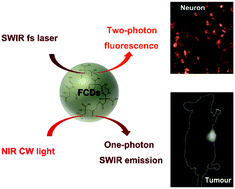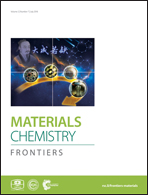Short-wave infrared emitted/excited fluorescence from carbon dots and preliminary applications in bioimaging†
Abstract
Fluorescent carbon dots (FCDs) have attracted tremendous attention in biological applications. The short-wave infrared (SWIR, 900–1700 nm) spectral range is considered as a novel optical tissue window due to low photon scattering. In this work, we investigated the fluorescence characteristics of FCDs based on the SWIR spectral range. SWIR emissions were observed from FCDs for the first time, when long-wavelength excitation (e.g. longer than 731 nm) was adopted. Wavelength-tunable two-photon fluorescence could also be obtained from the FCDs, under 1000–1560 nm SWIR femtosecond (fs) excitation. Interestingly, when an fs excitation wavelength as long as 1560 nm was adopted, two typical nonlinear optical signals, namely two-photon fluorescence and third harmonic generation (THG), could be observed. Based on the one-photon SWIR fluorescence, FCDs were successfully utilized for in vivo sentinel node mapping and tumour imaging. Under SWIR fs excitation, FCD-assisted two-photon fluorescence microscopy realized deep-tissue imaging of zebrafish embryos and the brain neuron networks of mice. SWIR excited and emitting FCDs have potential as fluorescent probes for deep-tissue and high-contrast functional bioimaging and related applications in the future.



 Please wait while we load your content...
Please wait while we load your content...